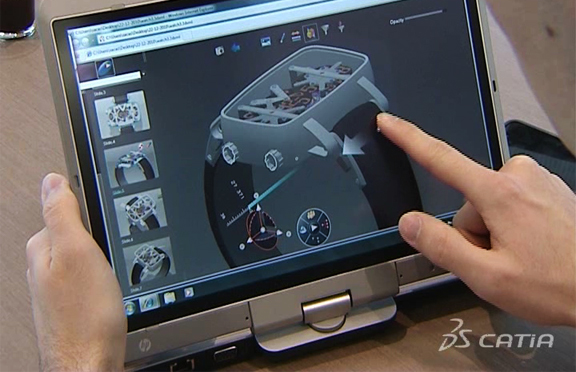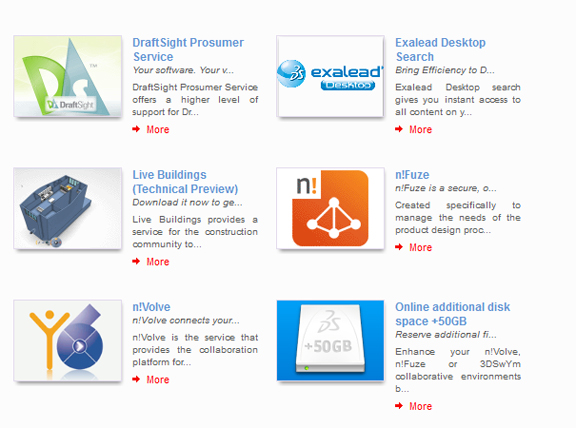Latest News
July 7, 2011
There’s clearly a sea change in the enterprise software business. Most of these software suites are known by three-letter acronyms: ERP (enterprise resource management), PLM (product lifecycle management), PDM (product data management), and SCM (supply chain management), to name but a few. They used to be clunky, heavy, and difficult to use. They’re centralized repositories with rigid rules, accessible only from designated desktop client interfaces (often not very exciting). The relief they offer is usually offset by the headaches they create. Employees usually fight them tooth and nail before they adopt them begrudgingly. People just don’t flock to enterprise software they way they did with Angry Birds or Facebook.
Now, stealing a few tricks from Apple apps and social media, enterprise software developers are remaking their products to match the behavior of the nomadic herd, always on the go, always connected. This week, Dassault Systemes publicly released its V6R2012 PLM platform, cloud-ready from the start, complemented with an app store.
Dominique Florack, senior executive VP of Product R&D at Dassault Systemes, said, “I am very pleased to introduce our first cloud-based 3D and PLM collaborative services taking advantage of state of the art SaaS/IaaS [software as a service/infrastructure as a service] for our customers. With the 3DS experience platform, every developer can now benefit from our online Version 6 open organic architecture.”
From its newly launched 3DStore, Dassault will offer social media-style collaboration solutions. Among the first ones to appear in the catalog are:
- 3DSWYM, a crowd-sourcing and community-building platform;
- n!fuze, a collaboration app for SolidWorks users; and
- n!volve, a collaboration app for CATIA V6 users.
PLM has traditionally been implemented in a secure, firewall-enclosed, client-server architecture—what some might call “a private cloud.” With V6, Dassault customers will have the option to deploy and manage Dassault products—brands like CATIA, SolidWorks, SIMULIA, DELMIA, ENOVIA, 3DVIA, Exalead, and 3DSWYM—on Amazon Web Services. The move pushes PLM from private to public cloud—an area some feel is still vulnerable to security breaches and unexpected failures.
Fabien Fedida, Dassault’s senior director for global marketing, pointed out, “By partnering with Amazon, we get the benefit of Amazon’s service level agreement (SLA).” The cloud-service provider explicitly states in its SLA that it “will use commercially reasonable efforts to make Amazon EC2 available with an Annual Uptime Percentage ... of at least 99.95% during the Service Year.”
Fedida emphasized, “Cloud-hosted capabilities in V6 will not be restricted to data management and visualization. They will include 3D authoring.”
While it’s relatively easy to transmit and receive small chunks of data for data management in cloud, certain 3D modeling protocols that involve larger volumes of data may test the bandwidth limits of cloud-hosted setups.
Cost for PLM apps distributed through Dassault’s 3DStore varies, with some as cheap as your typical iPad or iPhone apps. n!Volve, for example, costs $300 per user per month; n!Fuse $70 per user per month; additional online storage $50 per user per month (for 50 GB); 3DSwYm $25 per user per month; 3DVIA Mobile HD for iPad $4.99; and 3DVIA Mobile for iPhone $1.99.
Even the costliest of the bunch is priced much less than what a typical CAD or PLM seat costs, but bear in mind: While some apps like 3DVIA Mobile and 3DVIA Mobile HD (for visualizing and interacting with 3D models) can be used by themselves, you’ll need a desktop client to take full advantage of others like n!Fuze and n!Volve.
Along with cloud-hosted implementation, Dassault is also bolstering some of its brands with multi-touch support. According to the company, “The multi-touch experience is applied to 3D design through CATIA direct modeling in Live Shape ...” (Before you go online to look for an iPad app for CATIA, let me stop you. Dassault’s multi-touch support is currently available only for tablet PCs or multi-touch-enabled displays, not on mobile devices yet.)
With different customers migrating to new versions at their own pace, one of Dassault’s challenges during new releases has always been version compatibility—making sure those working in older versions can exchange data with those in new versions without data loss or data corruption.
To ease the transition to V6, Dassault says, “In V5R21, Dassault Systèmes delivers upward and downward compatibility between CATIA V5 and V6 data that is equivalent to the compatibility between two releases of V5. In addition, V5R21 supports collaborative relational design between CATIA V5 and Version 6, enabling best in class collaboration between OEMs and their supply chain. The original decision to maintain the same geometry kernel between V5 and V6 also makes hybrid design environments much more efficient than previous version-to-version collaboration.”
Along with Dassault, its rivals in the CAD and PLM market—Siemens PLM Software, PTC, and Autodesk—are also revamping their software, injecting social media-inspired features and mobile apps to appeal to the Facebook generation. Currently in development, PTC’s iPad app for Windchill will let you explode an assembly by shaking the device—not too far from how you would catapult a bird to explode a glass house in Angry Birds.
Subscribe to our FREE magazine, FREE email newsletters or both!
Latest News
About the Author
Kenneth Wong is Digital Engineering’s resident blogger and senior editor. Email him at [email protected] or share your thoughts on this article at digitaleng.news/facebook.
Follow DE







